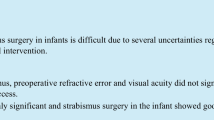Abstract
Purpose
To determine the relative prevalence of Duane’s retraction syndrome (DRS) in a population of Iranian strabismus cases and to describe the clinical features.
Methods
Retrospectively, a population of 7,349 strabismus cases visited during 2000–2003 were evaluated for the diagnosis of DRS. Data regarding onset (noticed age), type, head turn, primary position deviation, narrowing of the palpebral fissure, leash phenomenon, refractive error, amblyopia, and history of surgery were collected. Chi-square test and Student’s t-test were used.
Results
About 125 DRS cases were diagnosed (prevalence: 1.7%). The noticed age of the syndrome was at birth in 35.6%, during infancy in 25.4%, or childhood in 39.0%; the age at referral ranged from 3.5 months to 65.0 (median: 10.0) years. The female/male and left/right eye involvement ratios were 3:2 and 3.5:1, respectively. The syndrome was of type I in 87.0%, II in 6.5%, and III in 5.7%; 7.2% were bilateral. Horizontal deviations existed in 76.0% and vertical deviations in 12.8%. 26.8% had different degrees of amblyopia. Leash phenomenon was detected in 37.6% of cases. Head turn, primary position deviation (without turn), and orthophoria were observed in 71.2%, 13.6%, and 15.2%. Surgery had been performed in 71.2% of the cases. Vertical deviations and leash phenomenon were more common in types II and III and hypermetropia in type I (P values: 0.036, <0.001, and 0.025, respectively).
Conclusion
Basic features of our series seem to be comparable with previous reports. The incidences of bilateral involvement and type III syndrome were lower. The proportion of cases with head turn was higher and surgery was performed more frequently.
Similar content being viewed by others

References
DeRespinis PA, Caputo AR, Wagner RS et al (1993) Duane’s retraction syndrome. Surv Ophthalmol 38:257–288
Gutowski NJ (2000) Duane’s syndrome. Eur J Neurol 7:145–149
Chung M, Stout JT, Borchert MS (2000) Clinical diversity of hereditary Duane’s retraction syndrome. Ophthalmol 107:500–503
Marshman WE, Schalit G, Jones RB et al (2000) Congenital anomalies in patients with Duane retraction syndrome and their relatives. J AAPOS 4:106–109
Mohan K, Saroha V, Sharma A (2003) Factors predicting upshoots and downshoots in Duane’s retraction syndrome. J Pediatr Ophthalmol Strabismus 40:147–151
Shauly Y, Weissman A, Meyer E (1993) Ocular and systemic characteristics of Duane syndrome. J Pediatr Ophthalmol Strabismus 30:178–183
Zhang F (1997) Clinical features of 201 cases with Duane’s retraction syndrome. Chin Med J (Engl) 110:789–791
Young S (1997) Characteristics of Duane’s retraction syndrome at a clinic in South Africa. Surv Ophthalmol 42:295
Huber A (1974) Electrophysiology of the retraction syndromes. Br J Ophthalmol 58:293–300
Tredici TD, Von Noorden GK (1985) Are anisometropia and amblyopia common in Duane’s syndrome? J Pediatr Ophthalmol Strabismus 22:23–25
Tong L, Saw SM, Carkeet A et al (2002) Prevalence rates and epidemiological risk factors for astigmatism in Singapore school children. Optom Vis Sci 79:606–613
Hashemi H, Fotouhi A, Mohammad K (2004) The age- and gender-specific prevalences of refractive errors in Tehran: the Tehran Eye Study. Ophthalmic Epidemiol 11:213–225
Chua B, Johnson K, Donaldson C et al (2005) Management of Duane retraction syndrome. J Pediatr Ophthalmol Strabismus 42:13–17
Gurwood AS, Terrigno CA (2000) Duane’s retraction syndrome: literature review. Optometry 71:722–726
Busch NL, Envani CS, Frantz KA et al (1999) Familial Duane’s retraction syndrome. J Am Optom Assoc 70:123–131
Isenberg S, Urist MJ (1977) Clinical observations in 101 consecutive patients with Duane’s retraction syndrome. Am J Ophthalmol 84:419–425
Noonan CP, O’Connor M (1995) Greater severity of clinical features in older patients with Duane’s retraction syndrome. Eye 9:472–475
Acknowledgment
We thank Drs S-Ziaedin Yazdian, Iraj Ahadzadegan, Ali-Reza Keshtkar-Jafari, and Ahmad Ameri the faculty members of the Strabismus Division of Farabi Eye Hospital. This study was presented in the 15th Iranian Congress of Ophthalmology (Tehran, December 2005).
Author information
Authors and Affiliations
Corresponding author
Rights and permissions
About this article
Cite this article
Anvari, F., Hatef, E., Mohammadi, SF. et al. Duane’s retraction syndrome, a case series from Iran. Int Ophthalmol 28, 275–280 (2008). https://doi.org/10.1007/s10792-007-9125-y
Received:
Accepted:
Published:
Issue Date:
DOI: https://doi.org/10.1007/s10792-007-9125-y



